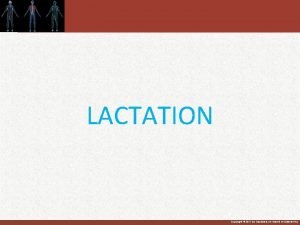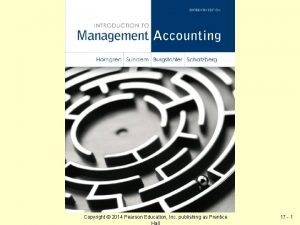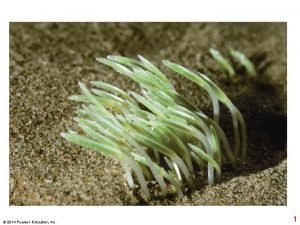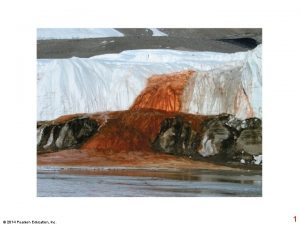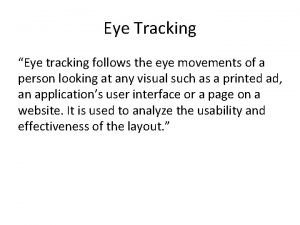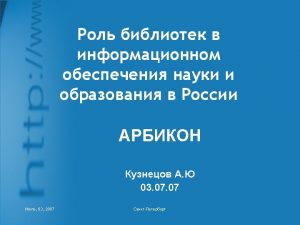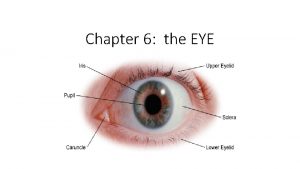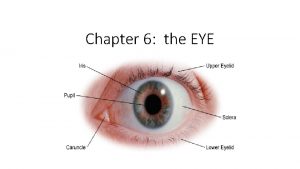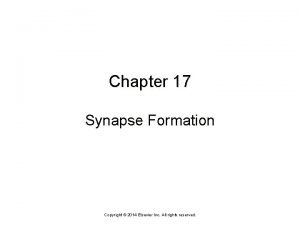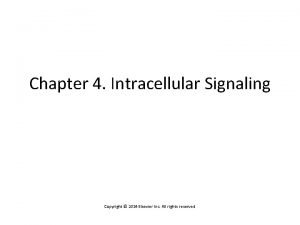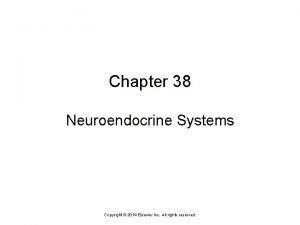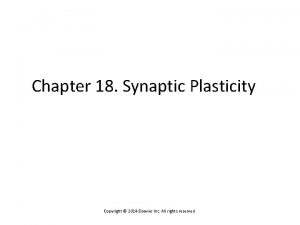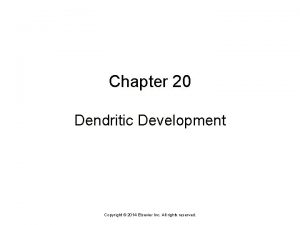Chapter 32 Eye Movements Copyright 2014 Elsevier Inc












- Slides: 12

Chapter 32 Eye Movements Copyright © 2014 Elsevier Inc. All rights reserved.

FIGURE 32. 1 Eye movements that stabilize gaze. The vestibulo-ocular reflex keeps the line of sight fixed in the world by counterrotating the eyes during movements of the head. Here, the eyes rotate rightward at a short latency after the beginning of the leftward head movement. The optokinetic response stabilizes the line of sight with respect to the moving visual surround, but does so after a longer latency. Copyright © 2014 Elsevier Inc. All rights reserved.

FIGURE 32. 2 Eye movements that redirect gaze. Saccades change the line of sight to place the retinal image of visual targets onto the fovea. They are characterized by rapid changes in eye position (upward deflection in eye position trace) involving very high eye velocities (brief pulse in eye velocity trace). Smooth pursuit continuously changes the line of sight tominimize blurring of the target’s retinal image. These movements are characterized by smooth and continuous changes in eye position (ramp in eye position trace) involving lower eye velocities (smooth step in eye velocity trace). Copyright © 2014 Elsevier Inc. All rights reserved.

FIGURE 32. 3 Muscles of the eye. Eye movements are controlled by six extraocular muscles arranged in three pairs, shown here in a cutaway view of the eye in its socket, or orbit. Copyright © 2014 Elsevier Inc. All rights reserved.

FIGURE 32. 4 Oculomotor nuclei in the brainstem. Parasagittal section through the brainstem, cerebellum, and thalamus of a rhesus monkey, showing the location of the major brainstem nuclei involved in the control of eye movements. Motor neurons for the eye muscles are located in the oculomotor nucleus (III), trochlear nucleus (IV), and abducens nucleus (VI), and reach the extraocular muscles via the corresponding nerves (n. III, n. IV, n. VI). Premotor neurons for controlling eye movements are located in the paramedian pontine reticular formation (PPRF), the mesencephalic reticular formation (MRF), rostral interstitial nucleus of the medial longitudinal fasciculus (ri. MLF), the interstitial nucleus of Cajal (IC), the vestibular nuclei (VN), and the nucleus prepositus hypoglossi (NPH). The medial longitudinal fasciculus (mlf) is a major fiber tract containing the axons of these neurons. Other abbreviation: MB, mammillary body of the hypothalamus. Copyright © 2014 Elsevier Inc. All rights reserved.

FIGURE 32. 5 The firing rate patterns of eye movement motor neurons during horizontal eye movements. The rapid rightward change in eye position, indicated by the upward deflection in the eye position trace, involves contraction of the right lateral rectus and relaxation of the right medial rectus. This is accomplished by a pulsestep increase in activity of the agonist motor neurons in the abducens nucleus, and a pause-step decrease in activity of the antagonist motor neurons in the oculomotor nucleus. Copyright © 2014 Elsevier Inc. All rights reserved.

FIGURE 32. 6 The eyemovements and neural circuits for the VOR. During a sustained rotation of the head (here, rightward), the eyes rotate slowly to the left (downward deflections in eye position trace labeled “slowphases”), and then abruptly shift rightward to reset the eyes toward a central position (upward deflections in eye position trace labeled “quick phases”). This is an example of right-beat nystagmus. The diagram of the basic VOR circuit shows the push-pull organization of the horizontal VOR. When the head rotates rightward, activity increases in the right semicircular canal, right vestibular nucleus (VN), and left abducens nucleus (VI). This leads to increased activation of the left eye lateral rectus and, through a crossed projection to the oculomotor nucleus (III), increased activation of the right eye medial rectus. The complementary set of pathways (colored in gray) show decreases in activity. Copyright © 2014 Elsevier Inc. All rights reserved.

FIGURE 32. 7 The brainstem circuits for controlling saccadic eye movements. This diagram of the saccade burst generator outlines the major classes of neurons involved in constructing the motor command for horizontal saccades. Omnipause neurons (OPN) located near the midline in the nucleus raphe interpositus (RIP) tonically inhibit excitatory burst neurons (EBN) located in the paramedian pontine reticular formation (PPRF). When OPNs pause, the EBNs emit a burst of spikes, which activate motor neurons (MN) in the abducens nucleus (VI) innervating the lateral rectusmuscle. The burst also activates interneurons (IN) which, in turn, activate motor neurons on the oculomotor nucleus (III) on the opposite side, innervating the medial rectus. Inhibitory burst neurons (IBN) show a pattern of activity similar to EBNs, but provide inhibitory inputs to decrease activation in the complementary circuits and antagonist muscles. Long-lead burst neurons (LLBN) show activity long before movement onset and provide an excitatory input to EBNs. Copyright © 2014 Elsevier Inc. All rights reserved.

FIGURE 32. 8 The brainstem and cerebellar circuits for controlling pursuit eye movements. During pursuit, the line of sight changes smoothly to follow the motion of the target. The smooth changes in eye velocity are often accompanied by small “corrective” saccades, indicated by the upward deflection in the eye velocity trace (dotted lines). The diagram outlines the circuits involved in constructing the motor command for horizontal pursuit. The major pathways involve projections from areas of the cerebral cortex via the pontine nuclei to the cerebellum (CBLM), which then modulates activity in nuclei associated with the VOR—namely, the vestibular nuclei (VN) and nucleus prepositus hypoglossi (NPH)—and also modulates activity in nuclei associated with saccades, such as the paramedian pontine reticular formation (PPRF). A second pathway involves projections from the pretectum to the pontine nuclei, as well as a direct projection to the vestibular nuclei and prepositus hypoglossi. Copyright © 2014 Elsevier Inc. All rights reserved.

FIGURE 32. 9 The descending pathways for controlling gaze movements, depicted schematically on a lateral view of the monkey brain. The superior colliculus (SC), located on the roof of the midbrain, is a major source of descending control signals. In the cerebral cortex, the major areas involved are the frontal eye fields (FEF), supplementary eye fields (SEF), lateral intraparietal area (LIP), middle temporal area (MT), and medial superior temporal area (MST). In the basal ganglia, a cascade through the caudate nucleus (CN) and substantia nigra pars reticulata (SNpr) provides inhibitory control over activity in the superior colliculus. These descending control signals are then converted into motor commands by circuits involving regions such as the reticular formation (RF), pontine nuclei (PN), vestibular nuclei (VN), and parts of the cerebellum such as the ventral paraflocculus (VPF), oculomotor vermis (OV), and fastigial nucleus (FN). Copyright © 2014 Elsevier Inc. All rights reserved.

FIGURE 32. 10 The superior colliculus and its retinotopic (or oculocentric) map of saccades and target positions. The left plot shows that electrical stimulation in the superior colliculus causes eye movements whose direction and amplitude depend on the location. Each arrow corresponds to a stimulation site in the left superior colliculus, and the length and direction of the arrow indicate the metrics of the evoked saccade. The evoked saccades are all directed rightward, but rostral sites are associated with smaller movements than caudal sites, and medial sites are associated with upward movements whereas lateral sites are associated with downward movements. The right plot summarizes these results in the form of a continuous map of saccades and target positions. As in the visual cortex, the representation of the center of the visual field is amplified. Adapted from Robinson (1972). Copyright © 2014 Elsevier Inc. All rights reserved.

FIGURE 32. 11 The scan pathdepends on the goals of the observer. Among other experiments, Yarbus (1967) monitored the eye movements of subjects as they viewed Repin’s painting The Unexpected Visitor and found that the pattern of eye movements depended on the task. When subjects were instructed to give the ages of the people, the scan path mostly settled on the faces, whereas when subjects were instructed to surmise what the family had been doing, the scan path included many more objects in the room. Copyright © 2014 Elsevier Inc. All rights reserved.
 Copyright 2014 pearson education inc
Copyright 2014 pearson education inc Saunders (imprint)
Saunders (imprint) Locomotor dance definition
Locomotor dance definition Superior oblique muscle
Superior oblique muscle What are the two types of physical components
What are the two types of physical components Subfalcine herniation
Subfalcine herniation 2014 pearson education inc
2014 pearson education inc 2014 pearson education inc
2014 pearson education inc 2014 pearson education inc
2014 pearson education inc 2014 pearson education inc
2014 pearson education inc 2014 pearson education inc
2014 pearson education inc 2014 pearson education inc
2014 pearson education inc Water cycle pearson education
Water cycle pearson education

